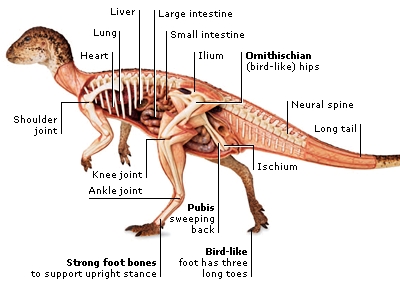DK Science: Bipedal Herbivores
As well as the giant plant-eaters, there were several other groups of smaller herbivores, including the ornithopods, which means “bird feet”. These successful and widespread dinosaurs first appeared 200 million years ago in the Jurassic and were abundant in the Cretaceous. They had ornithischian (bird-like) hip bones and a big plant-eating gut carried well back. This allowed the animals to walk and run away from danger on their hind legs. Unlike the sauropods, their teeth and jaws were adapted for chewing plant material.
The ornithopods chewed their plant food, so they did not need to swallow stones to process the bulky plant material that they ate. The large and small intestines were folded up and carried well back beneath the bird-like hips. The pubis bone was swept back, leaving room for the big digestive system between the legs.
Ornithopods, such as this Hypsilophodon, did not have long, sharp teeth or claws to defend themselves, so instead, they ran away from danger on two legs. Some of the smallest were among the fastest of all dinosaurs. Larger ornithopods, such as the hadrosaurs and iguanodonts, were too heavy to spend much time on their hind legs, so would walk and feed on all fours.
The skull of this Brachylophosaurus shows that this was an animal that could chew its food. The ornithopod would gather leafy plants with the bird-like toothless beak at the front of the mouth. The rows of teeth were set in from the side of the skull, suggesting that the back of the mouth was enclosed in prominent cheeks. The cheeks stored the plant food while it was being processed by the ridged cheek teeth. These would have ground the plant food to a pulp, ready for swallowing and digesting.
The teeth of an ornithopod were tightly packed together and arranged in ranks, or batteries, at the back of the mouth. Often the teeth were coarsely serrated like a cheese grater. The jaw was jointed in such a way that it allowed the surfaces of the teeth to grind past one another to pulp the plant food efficiently. The teeth wore out like the tooth on the right because of this constant grinding. They were replaced by new teeth that grew from underneath.
To order this book direct from the publisher, visit DK's website.








